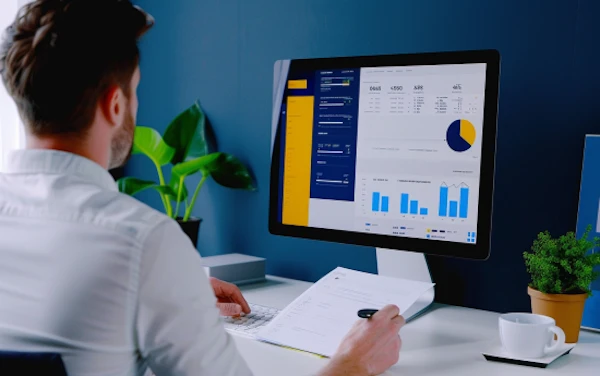Daily Bank Reconciliation: Expert Guide & Best Practices

Credit card swipe here, digital transaction there, and a payment transfer on the side. With the various payment processing and transaction options these days, the need for daily bank reconciliation is greater than ever. At any reconciliation frequency and transaction volume, automation solutions can help to streamline the process.
In this article, we’ll take a look at best practices for performing bank reconciliations and see the benefits of automating any bank reconciliation statement.
Coming Up
1. What is Bank Reconciliation?
2. What are the Benefits of a Bank Reconciliation?
3. How to Reconcile a Bank Statement?
4. What are Bank Reconciliation Steps?
5. How to Do Bank Reconciliations More Easily?
6. How to Use Bank Reconciliation Software?
7. What are the Challenges of Bank Reconciliations?
8. How to Overcome Bank Reconciliations Challenges?
9. How Often to Reconcile Bank Statements?
10. What are Common Bank Reconciliation Questions?
What is Bank Reconciliation?
Bank reconciliation is the accounting process of comparing records to ensure accuracy. For a bank reconciliation, you cross-check the bank statement with your internal business accounts to make sure that ending balances align and the records match.
In the event of a mismatch, it’s up to you to figure out what caused the discrepancy and fix it so that your financial statements are reflective of reality.
As you can imagine and have probably experienced, the reconciliation process can quickly become time-consuming and complex. With the growing number of transactions and payment process providers, your bank statement just gets longer and more complex.
Automation solutions replace your manual bank reconciliation formula and can execute reconciliations for you by pulling data in real time from multiple sources and cross-checking records in minutes, rather than hours or days.
What are the Benefits of a Bank Reconciliation?
Suffice it to say that there are many benefits that come along with accurate business accounts. Here’s a look at why it’s so valuable to perform bank reconciliations at an acceptable frequency:
1. Understand Financial Health
Most business decisions that you make will take into account your financial position and health. As such, you want to rest assured and have confidence that your accounts are up-to-date and correct.
When you perform daily bank reconciliation, you’ll be able to know that records are up-to-date and right. If they aren’t, you’ll be able to pinpoint the issue or exception.
2. Know Your Cash Flow
With bank reconciliation, you can see how money comes in and out of your business. This will help to inform your decisions, as well as be able to maximize profits and minimize expenses accordingly.
3. Correct Bank Errors
Although it’s not too common, banks can make mistakes. They may be charging you an extra fee or could have miscounted a deposit, for example. If you don’t notice the mistake, then you won’t be able to notify the bank to fix it.
4. Reduce Fraud
Performing a bank reconciliation by itself can’t prevent fraud, but it can certainly let you know if it’s taken place. With daily bank reconciliation, you’ll be able to locate any fraudulent records faster, which makes it easier to limit its negative consequences.
How to Reconcile a Bank Statement?
Before you start the bank reconciliation process, make sure that your books are up-to-date. Be sure you have access to all the data and accounts you need to go through the records and transactions.
Keep in mind: An automation solution with designated access controls will help you be able to pull data from disparate sources to save you time.
What are Bank Reconciliation Steps?
The general steps for a bank reconciliation is the same, regardless of the frequency at which you conduct it. Here’s the overall flow from a bird’s eye view:
1. Collect Records
Pull together your bank records with a list of transactions. You may get this online through your bank or in a printed statement that was sent to you. If you’re using accounting and automation software, you’ll be able to link your bank data to your centralised system.
At the same time, get your company’s ledger, which may be in a spreadsheet, logbook, or accounting program.
2. Review Records
Be sure to check your:
- Income and expenses in your books to see that every line item is accounted for in its respective bank statement
- Deposits and withdrawals are properly accounted for in the bank statement
3. Adjust Bank Statements
If the bank has failed to account for any transaction, you’ll need to remedy it by adjusting the bank statements. There are several explainable causes for mismatching line items, such as outstanding checks or bank deposits that are still in transit, to name a few.
4. Adjust Cash Balance
Check your cash account to make sure that all charges and deposits are reflected. For more on how to do cash reconciliation, review this guide.
5. Review Ending Balances
After all necessary adjustments have been made, make sure that the end balances in your bank statement and internal ledger match. If something is still misaligned, repeat the process.
6. Send for Approval
It may be the case that you’re not the only set of eyes responsible for the bank reconciliation. After you’ve done your tasks, send off the reconciliation for approval.
How to Do Bank Reconciliations More Easily?
The headache of having to source all your data and manually match it can be avoided with the aid of an automation solution. Software will expedite the time it takes to perform any type of reconciliation, and at the same time, it’ll improve the accuracy by preventing human errors.
How to Use Bank Reconciliation Software?
With a low code or no code bank reconciliation software at your fingertips, you’re ready to get started reconciling immediately! Simply fire up the system and let it do the work for you.
Reconciliation software will connect to your data sources via APIs or data uploads. With access to the necessary records, the automated solution will perform transaction matching and alert you should there be any anomaly.
The software can connect with multiple payment processing systems, including PayPal, Amazon, Stripe, Worldplay, and more, as well as any legacy systems you’re already using.
If you need to take any action, you can update the system after performing any investigation. Once everything shows in order, the software can store all the data for you for reference or can produce audit trails, should the need arise.
Furthermore, with the use of an automation solution, everyone who has access to the system will gain transparency in knowing where the process currently stands. This helps add internal control and oversight to an already meticulous process and also removes any key person dependencies that may otherwise cause delays.
What are the Challenges of Bank Reconciliations?
When conducting bank reconciliations, there are some common problems and challenges you may witness time and time again. Being aware of what they are will help you rectify them faster and without hassle.
These “problems” include:
1. Uncleared Checks
If you have made payments with a check, it could be the case that they have yet to be deposited (or presented). To manage these, make a note of them as “uncleared checks” in your accounting software.
This way, they’ll continue to be reconciled over following accounting periods. If the check continues to be uncleared, consider contacting the payee to see if they got it or if it needs to be voided and resent.
2. Wrongfully Cleared Checks
If you have sent a replacement check, but somehow the payee was still able to deposit the original check, then you’ll run into a discrepancy. Be sure to void the check with the bank or pursue repayment if they’ve been paid twice.
3. Returned Checks
In the event a bank refuses to deposit a check, then you have to reverse your original accounting entry. That also entails a credit to the cash account and a debit to the accounts receivable account to balance out.
How to Overcome Bank Reconciliations Challenges?
The best way to overcome the challenges of bank reconciliations is to stay on top of them! Importantly, be sure to separate your business accounts from personal use so that transactions are easier to follow.
The more frequently that you are able to perform bank reconciliations, the easier they’ll become because you’ll have less transactions to review, which means there’s a lower likelihood of running into errors each time.
The aid of an automation solution makes it easy to execute daily bank reconciliations, which is especially important for high-volume transaction businesses. Reconciliations that take days can now be completed in just a few minutes. Put simply, automation improves your reconciliation template by removing the need for tedious and manual labour.
How Often to Reconcile Bank Statements?
The rule of thumb is to conduct a bank reconciliation every time you receive a bank statement. Typically, businesses do this at the end of a month as part of the month-end close process.
However, as we just said, the more often the reconciliation, the less often the problems. Hence why we are such big proponents of daily (or even weekly) bank reconciliation.
What are Common Bank Reconciliation Questions?
To help ease the process and cover all the bases, check out these FAQs.
Does everything have to match up exactly the same?
It could be the case that transactions don’t always run through your bank account solely. Be sure to make note of those and keep a record so everyone is aware of these transactions.
My records aren’t matching. What could I be missing?
Perhaps you have bank fees that you’ve forgotten about. Be sure to account for those deductions to line everything up.
Why are transactions missing?
There’s a lag time between when a transaction occurs and when it shows up on a bank account. This could explain the confusion.
How big is the demand for accounting automation solutions?
By 2026, the global accounting software market will be worth $11.7 million.
Wrap Up
Initiating a daily bank reconciliation practice will undoubtedly help ensure that your company’s financial health is in check and well-maintained. As the amount of payment processors and transactions grow, it becomes increasingly vital and necessary to do so.
Automation solutions can execute the reconciliation process for you from start-to-finish, thereby saving you time and money while reducing errors and fraud.
FAQ
Intelligent reconciliation solution
Intelligent rebate management solution
Intelligent financial automation solution
Intelligent Financial Automation Solution
Intelligent financial automation solution
Intelligent financial automation solution
Intelligent financial automation solution
Intelligent financial automation solution
Intelligent regulatory reporting solution
Free up time and reduce errors
Recommended for you

Request a Demo
Book a 30-minute call to see how our intelligent software can give you more insights and control over your data and reporting.

Reconciliation Data Sheet
Download our data sheet to learn how to automate your reconciliations for increased accuracy, speed and control.

Regulatory Reporting Data Sheet
Download our data sheet to learn how you can prepare, validate and submit regulatory returns 10x faster with automation.

Financial Automation Data Sheet
Download our data sheet to learn how you can run your processes up to 100x faster and with 98% fewer errors.

Financial Automation Data Sheet
Download our data sheet to learn how you can run your processes up to 100x faster and with 98% fewer errors.

Financial Automation Data Sheet
Download our data sheet to learn how you can run your processes up to 100x faster and with 98% fewer errors.

Financial Automation Data Sheet
Download our data sheet to learn how you can run your processes up to 100x faster and with 98% fewer errors.

Financial Automation Data Sheet
Download our data sheet to learn how you can run your processes up to 100x faster and with 98% fewer errors.

Financial Automation Data Sheet
Download our data sheet to learn how you can run your processes up to 100x faster and with 98% fewer errors.

Rebate Management Data Sheet
Download our data sheet to learn how you can manage complex vendor and customer rebates and commission reporting at scale.

Top 10 Automation Challenges for CFOs
Learn how you can avoid and overcome the biggest challenges facing CFOs who want to automate.
.svg)









